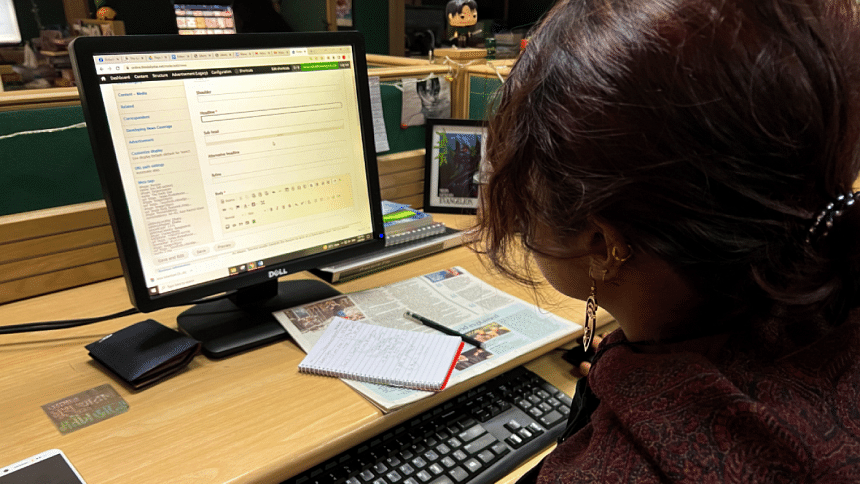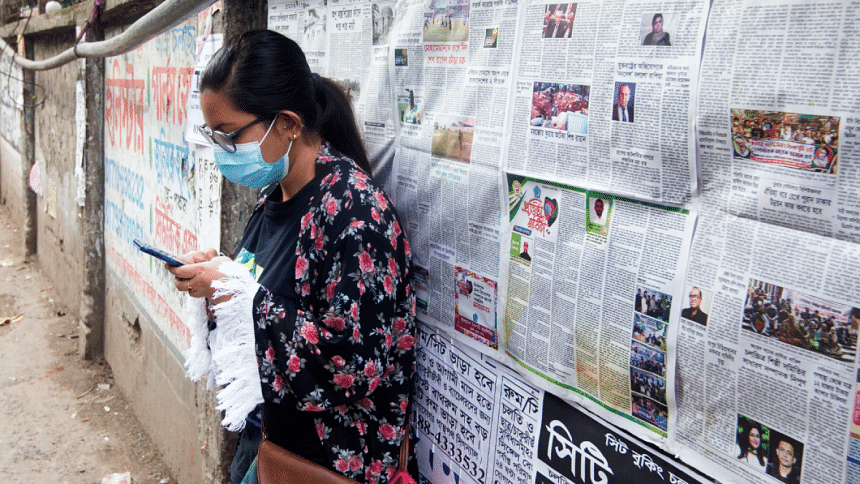Is traditional media catering to the youth?

Over 30 percent of Bangladesh's population is below the age of 24. Despite occupying such a large part of the population, the voice of youth is often drowned out by the chaos that looms over this country.
As young people, we have been trained to look up to our elders for guidance. Our opinions are often disregarded under the excuse that we lack the experience to decide what is right.
In a way, they aren't wrong. Youth makes us stubborn, fierce, and passionate. We can take that flame and burn the world to cinders, or we can light the way to a better world. Due to our inexperience, we often feel powerless against the higher powers that govern society. It is as though we are being swept off by an invisible current.
Those feelings of helplessness aren't assuaged by silence. We can only overcome it by taking matters into our own hands.
There is a disconnect between the events that take place and the part of the population impacted by the news. The absence of information breeds apathy. The greatest weapon in our arsenal to bridge that gap is social media. Social media was created in order to hold onto connections and keep tabs on people, but it has evolved into much more than that.
Today's youth have come to rely less and less on news media involving newspapers, news telecasts, chat shows, and so on. What has prompted such a change in how news is consumed amongst the youth?
Eighteen-year-old Asmita Zurafa Rahman explained her thoughts, stating, "Legitimate news outlets are held to a higher standard than my mom's friend who said arsenic could cure Covid, but when they complain about the green M&M mascot not being 'hot' anymore on Fox News, you realise that figuring out which outlets to trust is a part of obtaining news, no matter where you're getting it from."
Most of today's youth population is made up of digital natives who opt against consuming news generated by traditional news media, relying on more contemporary modes of communication instead, namely social networking sites. Let's look at Generation Z, who spend a significant portion of their time interacting with each other on social media sites and apps on their smart devices, which grants them constant and nearly unlimited access to news circulated globally through social media.
University student Mubashshir Muntaha Bari, 22, says why he prefers consuming news generated by different news media, "I think people who are used to reading a newspaper will surely put in the time and effort to procure and read one. But for us teens and young adults, living fast-paced lives, it's more convenient to consume bite-sized content on a daily basis. You're able to get to the important parts of a particular news in just one infographic instead of sifting through multiple articles you'd rather skip."
The circulation of news on social media has fuelled an increased number of online debates on social networking sites, indicating that the youth feel empowered enough online to come forth with their unfiltered thoughts in civil discourse. Live updates on events and protests get passed around Facebook and Twitter faster than news on the internet.
Social media has become the alternative for mainstream journalism for young people. As such, the content needs to be curated in order to cater to its target audience. At a time when the average person's attention span is considerably low, the youth can't be expected to stay glued to the television screen or sift through several pages of the morning newspaper.
"When we first started out, we saw that there was a vacuum in the Bangladeshi news industry where there was no variation in how the content or news was being presented. While there's nothing inherently wrong with traditional news media, it still felt like we were missing out on something. We eventually came to realise that what we're actually missing out on is quick, bite-sized news and micro-content," stated Tanzil Kabir, chief editor and co-founder of Cablgram, based in Bangladesh.
A Reuters Institute study revealed that the majority of the youth prefer to engage with news presented through graphical storytelling in lieu of lengthy articles in print. Bite-sized content takes the cake on this one. News that has been singled out and filtered from several different channels for rapid consumption.

"Our main agenda is to publicise must-see news updates in the form of graphic imagery and digital pamphlets while providing an in-depth look into a particular news through means of our insightful captions," said Saikat Saha, founder of Poligram., a social-media based news agency catering to Bangladeshi youth.
In the present day, the youth expect to have their opinions and stories represented in the news as adequately and accurately as possible. Conversations and debates on social networking sites have offered just that. On social media, every interacting individual is provided with some sense of agency in the form of a virtual platform that allows them to present opinions and share ideas.
Raisa Rashed, former feature writer at Dhaka Tribune, commented, "While we have come across features and op-ed pieces that consistently reflect the preferences of youth-centric content and we have seen adequate coverage of youth-led movements, such as the road safety and anti-rape protests, traditional news media continues to fall short in capturing the rich diversity that is eminent in our cohort. Youth today are unapologetically vocal about their opinions on everything from inclusivity to religion, an attitude that traditional news media are perhaps yet to adopt, forcing them to constrain the amount of 'polarising' content they can push."
Given the aforementioned issues associated with traditional news media and their declining appeal amongst today's youth, one can't help wondering if more contemporary forms of news media could somehow act as a replacement.
Looking at the logistics involved, the short answer would be "no." News circulated through traditional news media undergoes extensive verification and vetting procedures that don't usually apply to the news collected from social media. Traditional news media also possess the necessary resources that ensure the immediate and insightful generation of credible news. Furthermore, there have been growing concerns regarding copyright infringement when it comes to journalists covering a story for traditional forms of news media. The operating ethics of news aggregator sites online have previously come under fire for acquiring monetary profit off of news sourced by journalists who work independently of such internet sites. An example of the issue can be seen in the lawsuit brought by the Associated Press against contemporary form of news media Meltwater in 2012. The lawsuit against Meltwater pointed out the news portal's operations as a "..'closed aggregation service' charging a fee for the content it provides and doesn't drive Internet traffic to the sources whose content it uses."
Mehrin Newaz, a final-year engineering student writing for Prothom Alo, shared, "Speaking from personal experience, a lot of pieces I've written have ended up at random news portals with no credit whatsoever. Tracking down the right people, getting their interviews, phrasing their words into news-worthy content is no easy feat. I think credit should be given where credit is due. Even if I'm not making money out of it, I would still like to know where and how my work is being used."
Keeping these factors in mind, young journalists working for Bangladeshi news publications strongly encourage traditional news media to take up certain measures to improve their representation of youth issues and youth-centric content in general.
"Normally, traditional news media is run by those who do not have a firm grasp of youth issues. This is why diversifying the newsroom, to give youngsters a chance to pursue stories relevant to them, could be a good step towards ensuring better representation of youth opinions in traditional news media," said Shoaib Ahmed Sayam, a sub-editor working at The Daily Star.
Mehrin further added, "The youth culture of Bangladesh is changing very rapidly. I think representation should come from the people who have real-life experience of the things that are being spoken of. Letting young people express themselves on traditional news platforms should have a greater impact than having other people speak for them."
We have seen students take to the streets to protest against violence. We have seen them rally against injustice. We have also seen our nation's youth pull off incredible feats, here at home and abroad. Yet, traditional media has not been able to ingrain themselves with the ethos of this vibrant young population. That needs to change.
How else do we expect to empower the youth to keep moving forward?

 For all latest news, follow The Daily Star's Google News channel.
For all latest news, follow The Daily Star's Google News channel. 








Comments